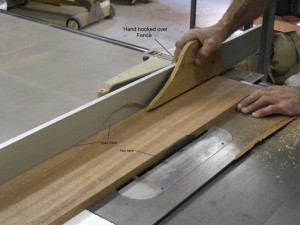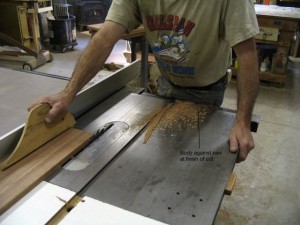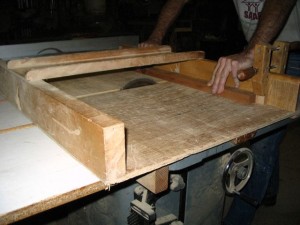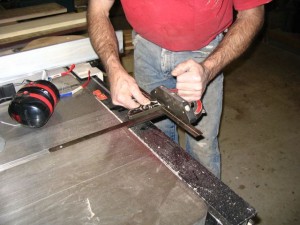It may seem obvious at first how to use a table saw. What could be more simple than placing your wood on the table and pushing it through the saw. In order to safely and accurately use this machine you will need to be made aware of some basics.
The table saw is probably one of the more dangerous machines in your shop, so beside some precautionary measures, some accuracy techniques will be discussed.
First off, always use safety goggles when using a saw. The use of ear defenders is a matter of personal choice, but the quieter the operation, the less intimidated and less likely to react to a sudden noise you will be. Always use a push stick when you?er ripping narrow strips. Always try to stand to the side of the blade incase something gets launched, you won?t get hit. Remove any rings and roll up long sleeves. Remember the absolute best safety device in your shop is the one between your ears. Think about the operation you?re about to perform and the safest way to execute it before you start.
The table saw is a versatile machine that can rip lumber to width, accurately cut stock to length, size plywood components and even be used as a molder, although I would not recommend this practice without the use of a power stock feeder.
Always try to utilize the saw where the part you want is between the blade and fence. The drop should be able tot fall away from the blade at the end of the cut.
Never reach over the blade to retrieve the drop. If you must remove the drop, use a push stick or as I do, use the just cut stock to push it safely off to the side well after the cut.
Whenever you’re using the table saw for any cutting operation, with the fence to the right of the blade, always start the cut with your right hand hooked over the end of the stock and your left hand holding the stock against the fence. For the fence to the left of the blade the stance would be opposite.
As the stock proceeds past the blade, keep your eyes on the stock at the fence line and not the blade. The blade will cut regardless of you’re watching it. You want to be sure the stock doesn’t drift away from the fence.
Always use a push stick and NEVER, EVER back the stock up at mid cut. The back side of the blade will grab the stock and launch it into your face. If you need to stop the cut, just stop pushing on the stock and shut the saw off. After the blade stops you can then remove the stock.
Notice how my right hand is hooked over the fence while grasping the push stick. Should the stock catch the blade, my hand will not be sucked into the blade.
As the stock exits the blade, finish the cut with your body resting against the table. This ensures that should the stock get caught in the blade, you will not fall into the blade.
The fact that most all table saws have large shutoff buttons located low on the front of the saw body is no coincidence. They are placed there so that in the event where you cannot let go of your stock, with either hand after the cut, you can shut the saw off with your knee. I’ve gotten in such a habit of doing this; it’s primarily how I turn the saw off.
Develop some safe work habits. We are creatures of habit, in the event of an emergency you will be less likely to panic and lose some fingers.
When crosscutting stock to length, you can use the miter gauge or a crosscut sled.
Do not use the miter gauge with the fence alone. This setup will ensure a disaster as the stock will get pinched between the blade and fence.
The safest way to accomplish this task is to use a stop block against the fence well before the saw. Add the thickness of the block onto the desired length of your stock. Butt your stock against this block and using the miter gauge cut your stock to length.




